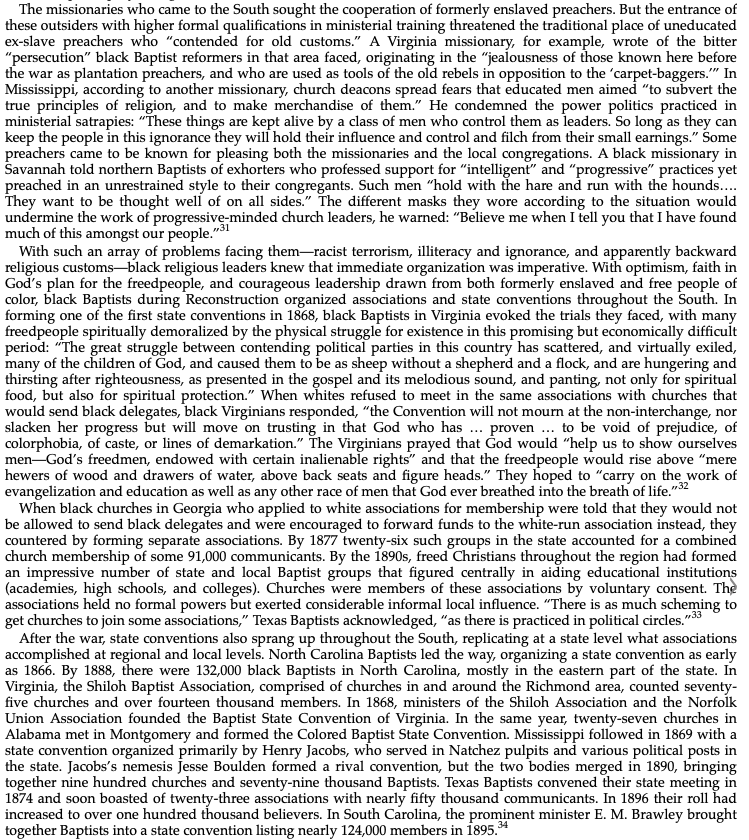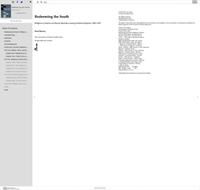Harvey notes that self-governance for separate Black Baptist congregations took root in the South after 1865.
- Type
- Book
- Source
- Paul Harvey Non-LDS
- Hearsay
- Secondary
- Reference
Paul Harvey, Redeeming the South: Religious Cultures and Racial Identities Among Southern Baptists, 1865–1925 (Chapel Hill, NC: The University of North Carolina Press, 2000), chapter 2, accessed March 10, 2022
- Scribe/Publisher
- University of North Carolina Press
- Audience
- Reading Public
- Transcription
With such an array of problems facing them—racist terrorism, illiteracy and ignorance, and apparently backward religious customs—black religious leaders knew that immediate organization was imperative. With optimism, faith in God’s plan for the freedpeople, and courageous leadership drawn from both formerly enslaved and free people of color, black Baptists during Reconstruction organized associations and state conventions throughout the South. In forming one of the first state conventions in 1868, black Baptists in Virginia evoked the trials they faced, with many freedpeople spiritually demoralized by the physical struggle for existence in this promising but economically difficult period: “The great struggle between contending political parties in this country has scattered, and virtually exiled, many of the children of God, and caused them to be as sheep without a shepherd and a flock, and are hungering and thirsting after righteousness, as presented in the gospel and its melodious sound, and panting, not only for spiritual food, but also for spiritual protection.” When whites refused to meet in the same associations with churches that would send black delegates, black Virginians responded, “the Convention will not mourn at the non-interchange, nor slacken her progress but will move on trusting in that God who has . . . proven . . . to be void of prejudice, of colorphobia, of caste, or lines of demarkation.” The Virginians prayed that God would “help us to show ourselves men—God’s freedmen, endowed with certain inalienable rights” and that the freedpeople would rise above “mere hewers of wood and drawers of water, above back seats and figure heads.” They hoped to “carry on the work of evangelization and education as well as any other race of men that God ever breathed into the breath of life.”
When black churches in Georgia who applied to white associations for membership were told that they would not be allowed to send black delegates and were encouraged to forward funds to the white-run association instead, they countered by forming separate associations. By 1877 twenty-six such groups in the state accounted for a combined church membership of some 91,000 communicants. By the 1890s, freed Christians throughout the region had formed an impressive number of state and local Baptist groups that figured centrally in aiding educational institutions (academies, high schools, and colleges). Churches were members of these associations by voluntary consent. The associations held no formal powers but exerted considerable informal local influence. “There is as much scheming to get churches to join some associations,” Texas Baptists acknowledged, “as there is practiced in political circles.”
After the war, state conventions also sprang up throughout the South, replicating at a state level what associations accomplished at regional and local levels. North Carolina Baptists led the way, organizing a state convention as early as 1866. By 1888, there were 132,000 black Baptists in North Carolina, mostly in the eastern part of the state. In Virginia, the Shiloh Baptist Association, comprised of churches in and around the Richmond area, counted seventy-five churches and over fourteen thousand members. In 1868, ministers of the Shiloh Association and the Norfolk Union Association founded the Baptist State Convention of Virginia. In the same year, twenty-seven churches in Alabama met in Montgomery and formed the Colored Baptist State Convention. Mississippi followed in 1869 with a state convention organized primarily by Henry Jacobs, who served in Natchez pulpits and various political posts in the state. Jacobs’s nemesis Jesse Boulden formed a rival convention, but the two bodies merged in 1890, bringing together nine hundred churches and seventy-nine thousand Baptists. Texas Baptists convened their state meeting in 1874 and soon boasted of twenty-three associations with nearly fifty thousand communicants. In 1896 their roll had increased to over one hundred thousand believers. In South Carolina, the prominent minister E. M. Brawley brought together Baptists into a state convention listing nearly 124,000 members in 1895.
- Citations in Mormonr Qnas
The B. H. Roberts Foundation is not owned by, operated by, or affiliated with the Church of Jesus Christ of Latter-day Saints.


